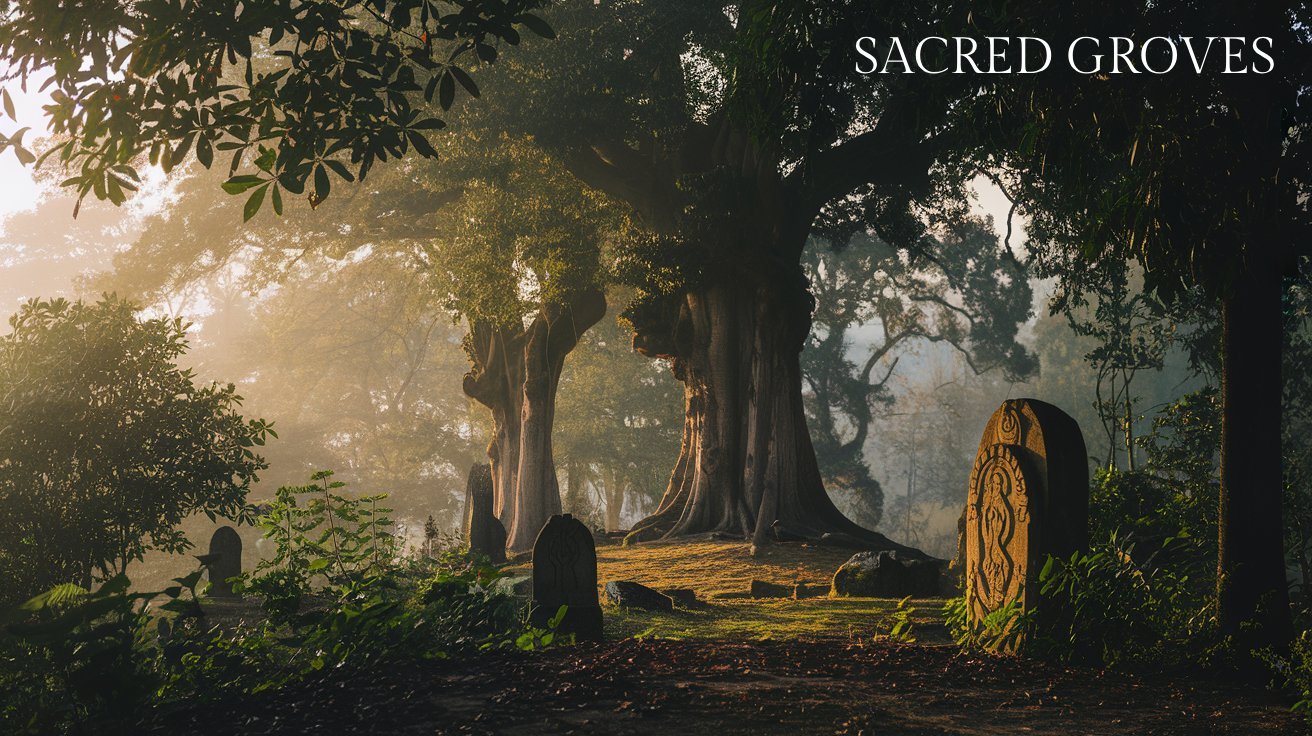Composed By-Ketan Goriwale
Have you ever walked into a forest and felt an almost sacred connection with nature? Imagine a place where every tree whispers ancient stories, every leaf holds divine significance, and every creature is protected under a canopy of cultural reverence. These are not just poetic musings but the essence of sacred groves—natural sanctuaries steeped in spirituality and ecological wisdom.
Sacred groves have been an integral part of human civilization for centuries. Across the globe, they stand as timeless guardians of biodiversity, cultural heritage, and spiritual harmony. But as modernity encroaches upon tradition, these havens are increasingly under threat, posing the question: are we losing more than just trees?
In this blog, we’ll explore the fascinating world of sacred groves—from their cultural origins and ecological importance to the challenges they face today. Together, let’s uncover why these natural treasures are essential not just to our environment but to our collective heritage and future.
The Ecological Significance of Sacred Groves
Did you know that a single sacred grove can act as a mini-ecosystem, housing rare plants, animals, and even microorganisms? These natural sanctuaries aren’t just places of worship—they are vital hubs of biodiversity and ecological stability. Let’s delve deeper into why sacred groves are so important to our planet’s health.
1. Biodiversity Hotspots
Sacred groves are often home to species that you might not find anywhere else.
- Rare medicinal plants thrive here, safeguarded by centuries of tradition.
- They provide shelter for birds, insects, and animals, many of which are endangered.
- Unlike urban parks, these groves sustain natural, untouched habitats.
By preserving sacred groves, we’re not just protecting these species—we’re maintaining the balance of entire ecosystems.
2. Natural Water Guardians
Ever wondered how these groves help maintain water cycles?
- The dense vegetation prevents soil erosion and increases groundwater recharge.
- Many sacred groves have ancient water bodies, such as ponds or streams, revered as holy.
- These water sources often serve as lifelines for nearby communities.
Protecting these groves means securing clean water for generations to come.
3. Climate Regulators
In an era of climate change, every effort to reduce carbon footprints matters. Sacred groves contribute significantly:
- They act as natural carbon sinks, absorbing CO₂ and releasing oxygen.
- The shade and greenery help moderate local temperatures, creating microclimates.
Imagine how preserving these groves could support global climate goals while improving local living conditions!
4. A Sanctuary for Pollinators
Sacred groves are buzzing—literally! Bees, butterflies, and other pollinators find refuge here.
- These creatures play a critical role in pollinating nearby crops and wild plants.
- Without such protected areas, pollinator populations could decline, impacting agriculture and food security.
Why It Matters
Sacred groves aren’t just cultural relics; they are living, breathing ecosystems that benefit humanity in countless ways. From purifying the air we breathe to supporting the delicate balance of nature, their importance cannot be overstated.
So, the next time you see or hear about a sacred grove, remember—it’s much more than a forest. It’s a legacy of nature and nurture, one that deserves our utmost respect and protection.
The Ecological Significance of Sacred Groves
Did you know that a single sacred grove can act as a mini-ecosystem, housing rare plants, animals, and even microorganisms? These natural sanctuaries aren’t just places of worship—they are vital hubs of biodiversity and ecological stability. Let’s delve deeper into why sacred groves are so important to our planet’s health.
1. Biodiversity Hotspots
Sacred groves are often home to species that you might not find anywhere else.
- Rare medicinal plants thrive here, safeguarded by centuries of tradition.
- They provide shelter for birds, insects, and animals, many of which are endangered.
- Unlike urban parks, these groves sustain natural, untouched habitats.
By preserving sacred groves, we’re not just protecting these species—we’re maintaining the balance of entire ecosystems.
2. Natural Water Guardians
Ever wondered how these groves help maintain water cycles?
- The dense vegetation prevents soil erosion and increases groundwater recharge.
- Many sacred groves have ancient water bodies, such as ponds or streams, revered as holy.
- These water sources often serve as lifelines for nearby communities.
Protecting these groves means securing clean water for generations to come.
3. Climate Regulators
In an era of climate change, every effort to reduce carbon footprints matters. Sacred groves contribute significantly:
- They act as natural carbon sinks, absorbing CO₂ and releasing oxygen.
- The shade and greenery help moderate local temperatures, creating microclimates.
Imagine how preserving these groves could support global climate goals while improving local living conditions!
4. A Sanctuary for Pollinators
Sacred groves are buzzing—literally! Bees, butterflies, and other pollinators find refuge here.
- These creatures play a critical role in pollinating nearby crops and wild plants.
- Without such protected areas, pollinator populations could decline, impacting agriculture and food security.
Why It Matters
Sacred groves aren’t just cultural relics; they are living, breathing ecosystems that benefit humanity in countless ways. From purifying the air we breathe to supporting the delicate balance of nature, their importance cannot be overstated.
So, the next time you see or hear about a sacred grove, remember—it’s much more than a forest. It’s a legacy of nature and nurture, one that deserves our utmost respect and protection.




